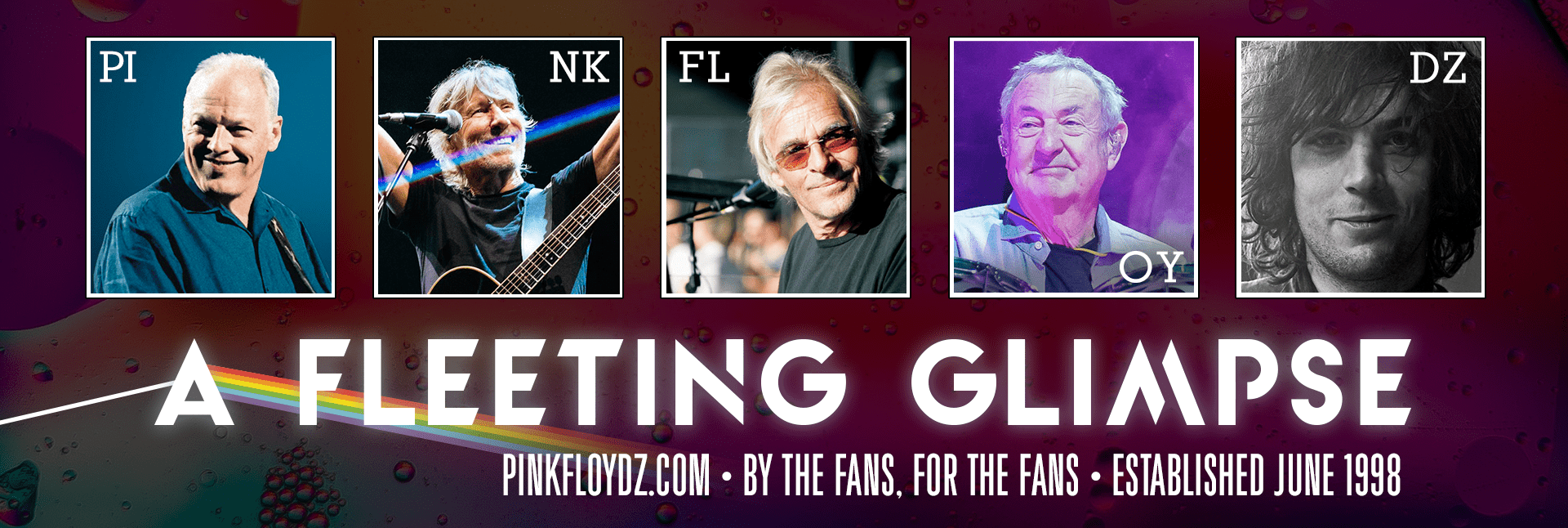In Harmony 2
An Exclusive AFG Interview With Jon Joyce
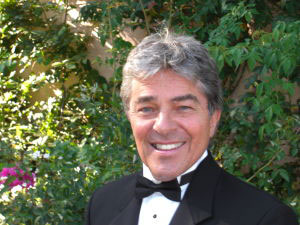
Jon Joyce
( photo courtesy of Beethoven’s Wig website)
AFG Wishes to thank Julie Skaggs for facilitating & conducting this interview.
The Wall – considered one of the great conceptual works of its auteur Roger Waters – has a fascinating past and an exciting present in the form of the 30th Anniversary Tour. Its history – as well as that of Waters as a performer – is reflected in the recreation of the songs and staging. Although there are many production changes to reference the new era in which it now plays to audiences there are also specific links to its past. One such important and unifying element is singer Jon Joyce, the only member of the touring band save Roger himself who has appeared on the original recording and every subsequent performance of the work to the present day. But Jon has contributed more than his own voice; he also facilitated the selection of the male chorus, as well as the vocalist who is reprising David Gilmour’s distinctive lead and harmony vocals for the shows.
Singing is literally in Jon’s DNA: born into a musical family in Los Angeles, the oldest of five children, his parents Jimmy and Betty Joyce were also vocalists and Jon was a member of the Jimmy Joyce Singers for most of his youth, appearing weekly on television programs such as The Carol Burnett Show and The Smothers Brothers Comedy Hour. A revered and in-demand session singer for over thirty years, Jon’s very first session was for a Frank Sinatra recording at age 12, and his credits are vastly numerous and varied as his rock-solid smooth baritone has graced commercials, television, film scores, albums, theatre, and live performance. In addition to singing Jon has also been active in the American Federation of Television and Radio Artists and the Screen Actors Guild unions, serving as an officer on the local and national boards for AFTRA for many years.
His entry into the Floydian world occurred in 1979 when Jon’s friend and mentor Bruce Johnston asked him to participate in the backing vocal sessions for The Wall, lending his voice to the harmonies which came to be such a memorable aspect of the recording. Jon, along with his long-time colleagues Joe Chemay, Stan Farber and Jim Haas, were selected as the original male chorus for the 1980-81 performances. The rest, as they say, is history…
It was my honor and pleasure to conduct this exchange with Jon on behalf of AFG, to hear from an individual who embodies part of the ongoing narrative of this masterwork as well as provides his own insights into its workings and its meaning for audiences today. My thanks to him for his time and thoughtful responses as well as sharing his talents with all Pink Floyd fans for 30 years.
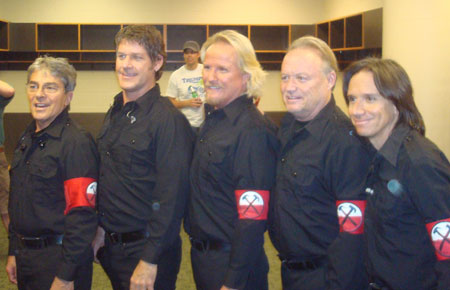
The Male Chorus with Robbie Wyckoff backstage in St. Paul, MN
(courtesy of Tim Russell)
Your talent runs – as it does for the Lennons – in the family, you were a member of your father’s vocal ensemble before becoming a session singer in 1971. What was it like to have a musical upbringing and the benefit of your family’s example in regards to your own career path?
I was the oldest of five boys my parents had. There were always vocal groups being formed. Besides the family show we did in the early seventies, my mom and dad, Jimmy and Betty, met in a vocal group with the Alvino Rey Band. That was in the early 40s. I remember dozens of singers coming to the house to rehearse for sessions and recordings. During that time, every singer coming to L.A. belonged to a group of guys or gals and was try to get a label deal. My family grew up with the King Sisters and their many sons and daughters. Dad started a music workshop for kids where we learned to read music and sing parts. When I was 12 years old, I had my first job, a record called “High Hopes” with Frank Sinatra. Most of the kids in the chorus were children of session musicians and producers so the level of sophistication was pretty high.
As you related in an interview in 1998, you had slowed your working pace a bit, and the opportunity in the form of the 30th Anniversary Tour presented itself with a great deal of work this year. I’m sure many would desire to know from a professional such as yourself how one prepares for such an undertaking, as well as keeps in fit form and voice over the course of more than 50 dates in North America.
I’ve never been on a tour this long. I was actually anxious about my mental and physical preparedness. I consulted friends that have toured extensively and months before leaving started examining my exercise and dietary habits. Yoga became one of my daily routines. Our vocal rehearsals that we started in July helped get the juices flowing. Actually, the vocal demands of this show are not high for me. I think my main focus in preparation was compiling and documenting all of the vocal bits and parts that we did 30 years ago. Stan Farber sent me his notes from the first Wall. I’m so grateful to him for keeping those records. Ultimately, I walk everyday. It’s how I get my diaphragm relaxed and in control. Breathing and support is the most important aspect of vocal preparedness. The Lennons are much more experienced in this road dog life. I’ve learned much from them about how to prepare mentally and physically each day for a performance. You have to carefully monitor the hotel atmosphere, AC, weather, etc to guard against infection and colds. My biggest worry is getting sick. So far, so good. We’re just over half through the U.S. leg of the tour.
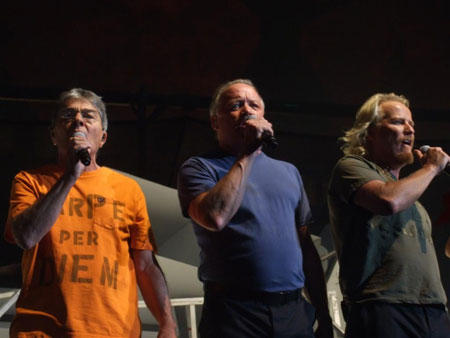
Jon Joyce and Pat & Mark Lennon performing “Outside The Wall”
(photo by Simon Wimpenny)
Your career has been incredibly varied as you’ve lent your voice to a wide range of styles and projects as a session singer. But rock n’roll performing and touring is especially familiar to you. How is the life of a touring musician now in the 21st Century compared to when you first hit the road in the 1970s with Elton John and the Beach Boys?
Well, let’s just say, the 70s were a totally different trip! If I could remember half of where I went and what I did from those days, I would be a wiser fellow. I don’t consider myself much of a road warrior. The Elton tours were a wonderful, star-filled, musical extravaganza. I came off those tours with the endorsement of success and as a result have enjoyed a special role in the session world as a rock-and-roller. It helped establish me as a sought-after session singer. That, in addition to the people I knew through my dad, has allowed me to have a diverse and rich association with a couple of generations of wonderful musicians, songwriters, producers, and singers.
Do you have a specific memory of the first time you met Roger Waters 31 years ago and what kind of impression he made upon you then?
Bruce Johnston asked Toni Tennille and me to sing on a Pink Floyd record in 1979 at a little studio in Hollywood called Producers Workshop. This gorgeous track and song called “Goodbye Blue Sky” was literally my introduction to the Floyd. Roger Waters and David Gilmour were directing us and seemed to know exactly what they wanted. I was totally captivated. When we finished recording and listening to the playback, Roger showed us these artist renderings of the Wall…the show they were planning to perform live. He was so enthused and almost childlike in his excitement about the concept. When he explained that the first half of the show would feature the building of a wall across the front of the stage, completely obscuring the band for the second half. I thought he was crazy. This was truly Roger’s story and he was both enthralled and possessed by it.
You have taken on the role for this tour, long-familiar to you, as the Vocal Contractor in that the suggestions for the male chorus and lead vocalist were yours, as Roger sought your specific advice. What qualities were uppermost in your mind in terms of the type of singer required by Roger?
When Roger called last November, I knew he wasn’t asking me to gather the old group together. At the same time, I knew he loved the sound we got with Jim Haas, Stan Farber, and Joe Chemay. These guys were the cream of the session world in Los Angeles so I was going to have to really get a sound that worked. Of course, the parts were conceived with a Beach Boys concept in mind. I thought of Kipp Lennon and his band Venice almost immediately. I hadn’t seen them in concert in probably 20 years. I knew Kipp to be a wonderfully versatile lead singer but also an experienced group singer. At first, I was looking for somebody who could cover David Gilmour leads as well as sing in the group. Marky was also deep into the session scene and another possibility. We started with the group sound which came beautifully. The four Lennons sang “Goodbye Blue Sky” for Roger and we thought….that’s it! The next task was covering the leads. When both Kipp and Mark were thought to be too light of a voice, I called Robbie Wyckoff. I’ve known Robbie for probably 20 years now and he has always been someone to call for a great lead. He has good ears and a great attitude. After an mp3 he recorded of “Hey You” got laid over the original tracks by James Guthrie, Roger suggested that we go up to Guthrie’s studio and record more of the critical vocals. Robbie, a meticulous preparer, went up there and tore it up. Robbie’s gift in this show is that he sounds enough like David but doesn’t sound like he’s copying him. He’s his own artist who can bring enough of the nuance of David’s unique voice to be thoroughly convincing.
The voices in this version of The Wall are largely new to Pink Floyd fans and I wonder if you could please “introduce” them to us as you had introduced them to Roger and James Guthrie during your initial discussions regarding singers.
So I’ve already profiled Robbie above. Each of the Lennons brings a unique quality to the whole. Kipp does all the duets with Robbie in the show and sings second below Pat. At our first vocal rehearsal in Venice, Kipp and Robbie sang like brothers. Their voices and phrasing locked immediately. It’s such a pleasure to listen to them sing together every night. Marky who has always shared most of the leads with Kipp in Venice probably has the hardest adjustment to make. He sings the third part and has had to adjust his focus from being out front to being just a cog in the wheel. Above all, Marky keeps the party merry. Most of the time spent on the road is not onstage. Marky’s the court jester. Pat sings top and to me is the perfect man for the job. His intonation is spot on. He’s a craftsman and the finish carpenter that is the group sound here. He’s steady and focused and I treasure his ears. Of course, we wouldn’t have the group we have if it weren’t for their years of singing together.
As well, I would appreciate it if you could give us a view to your former comrades – Joe Chemay, Stan Faber and Jim Hass – with whom you had worked on many projects in addition to The Wall, as the “unsung (singing) heroes” of the original male chorus.
Joe and his large family live in the Nashville area where he is still much in demand as a bass player and singer. I hadn’t really spoken to him for years until this spring. Stan Farber and his wife have remained close friends of ours over the years. Recently retired, he’s moved to the Austin, Texas area where he remains active singing with a church program. Jim Haas, an avid golfer moved some years ago to Phoenix, Arizona. More golf days there I guess. He’s still sings when he comes back to L.A. for certain projects but we don’t see one another much.
As the only member of the current touring band (besides Roger, that is) to have appeared on the original recording, the original tour and subsequent re-staging to the present day, what is your particular perspective on The Wall not only as a work of art and cultural touchstone, but also of its relevance to audiences today as you are experiencing their reaction for the third time now?
Actually, Snowy White was a member of the back up band in 1980. He and Gilmour shared the guitar duties and solos. While the music remains very true to the original and the original Scarfe animation is the same, this is a totally different Wall. Digital technology has made it possible to do so many more things visually with the wall. Roger’s world perspective and anti-war message has become much more the artistic focus as well. This rock-and-roll icon of a show is one of the few today that is embracing the fear, menace, and destruction that we are witnessing in the world today. It’s ironic that the wall itself is the vehicle for such a liberating and outward-looking perspective. Roger challenges his audience to wake up and take responsibility for the things that are happening in our world, and become active.
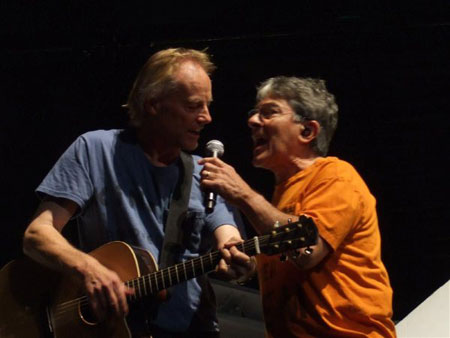
“Isn’t this where we came in?” Jon Joyce and Snowy White
(photo by Simon Wimpenny)
I had read you are the one to work with the groups of children who appear onstage with Roger at every performance during “Another Brick in the Wall Part II,” teaching them the choreography and leading them through the song in rehearsal. As a father and someone who has performed for children and families as a member of Beethoven’s Wig, what is specifically valuable to you in terms of not only exposing kids to great music, but encouraging their participation?
There is not really much in this show you would share with children. The one song the children sing stands out in its innocence. Roger is a grandfather now. He is enjoying his family. His son Harry plays in the band. The scenes in the show of children being reunited with their fathers just returned from war are especially poignant. The tragedy of families destroyed by war is one of the ongoing messages of The Wall. Kipp Lennon and I help to prepare the kids for performance in each new city we visit. We do it because we love being around kids. Roger says performing that song is one of the highlights of the show for him. Watching him, I believe it.
One of the most iconic moments of the new tour is the appearance of the band (but in particular Robbie and the male chorus) dressed in the “fascist” uniforms during the sequence which begins with “The Show Must Go On.” Originally the band was wearing costumes which differed from the familiar style you now have and I wondered if you could speak to that change as well as comment on how the drama of that moment in the show strikes you as a participant.
For one night, there was the idea of updating the look of the final songs of The Wall. It was thought that hoodies might accomplish that. They were hot onstage. I believe that those involved with the art direction all felt that the fascist costumes fit the overall message better. As our protagonist becomes more and more alienated from society, he becomes more and more psychotic. That moment of the show is funny to me. It’s wildly over the top and serves to propel the action to the final fantastic moments of “The Trial.” I love the music of “The Trial” and the voices Roger does in performing all the animated characters. It’s a dizzying nightmare concluding with the fall of the wall.
You are taking the stage with someone who considers you a mentor – Kipp Lennon – just as you had originally come to your involvement with Pink Floyd via your mentor Bruce Johnston. Do you feel a sense of completion, as it were, having passed on the opportunity to your friend and colleague much as you received it?
One of my greatest joys of this Wall show is that, except for Roger, we are performing all the vocals. This vocal unit couldn’t be more perfect. And Kipp’s talent has always amazed me. His harmonies with Robbie are spotless. From our early days of singing on Solid Gold, he has come through every time. He thanks me for this job, and I thank him for being such an artist. I’m grateful to have him in my life.
I imagine you have at least one treasured memory of each experience in regards to your involvement with The Wall and I wondered if you would be so kind as to share one with us, as you are the personification of living history and a witness to artistic and technical triumph via this enduring work in all its forms.
As we approached opening night in Los Angeles in 1980, the pressure to make all the details come together was tremendous. There was the syncing of pictures to music, the special effects, pigs, puppets, airplanes, prerecorded music and everyone involved was scrambling to make it happen. Roger oversaw every aspect of the production and in rehearsal, we often had to stop and wait for some detail that wasn’t quite worked out. Opening night came at the Los Angeles Sports Arena. The place was filled with 13, 000 anxious fans. Band and crew all held their breath. About 10 minutes into the show, Roger was heard to yell into his mike “Stop!” Apparently, some essential element of the show had not occurred. I don’t remember what it was but there was no way he was going on until it was worked out. The Wall 2010 is testament to his relentless artistic vision. It’s great that technology has finally caught up with him so that he could see The Wall the way he’d always envisioned it. And it’s still a work in progress.
To gain an appreciation for the sheer depth and breadth of Jon Joyce’s contributions to popular music – performing with hundreds of artists in just about any genre you could name – I suggest taking a gander at his credits as collected in such archives as
Discogs: https://www.discogs.com/artist/Jon+Joyce
IMDb: https://www.imdb.com/name/nm0431556/
AllMusic: https://www.allmusic.com/artist/jon-joyce-p91949
My enduring gratitude to Col Turner of A Fleeting Glimpse, Michael Lennon, and, of course, Jon Joyce!
AFG Wishes to thank Julie Skaggs for facilitating & conducting this interview.
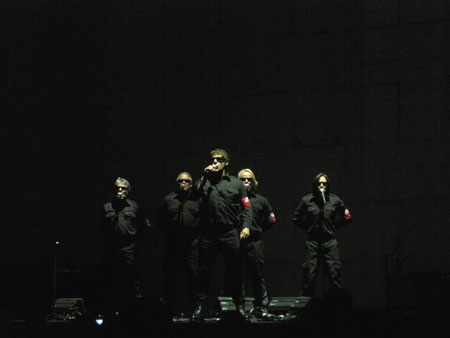
The Male Chorus with Robbie Wyckoff onstage in Chicago, IL
(photo by Robert Perry)
Be sure to also read the other exclusive interviews in this series with Michael & Kipp Lennon & Robbie Wyckoff
